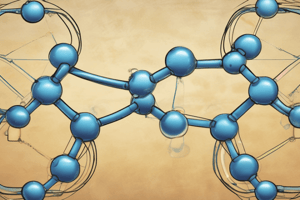Podcast
Questions and Answers
What distinguishes a coordinate covalent bond from a regular covalent bond?
What distinguishes a coordinate covalent bond from a regular covalent bond?
- It only occurs between identical atoms.
- It is formed when one atom donates both electrons. (correct)
- It is weaker than regular covalent bonds.
- It involves shared electrons from both atoms.
Which of the following correctly describes multiple bonds?
Which of the following correctly describes multiple bonds?
- Triple bonds involve one pair of electrons.
- All multiple bonds are weaker than single bonds.
- Single bonds involve three pairs of electrons.
- Double bonds involve the sharing of two pairs of electrons. (correct)
Which statement correctly describes bonding pairs and lone pairs?
Which statement correctly describes bonding pairs and lone pairs?
- Bonding pairs can be formed by electrons from one atom. (correct)
- Lone pairs do not influence molecular shape.
- Lone pairs are shared between two atoms.
- Bonding pairs are always present in a molecule.
What is a characteristic of Lewis structures?
What is a characteristic of Lewis structures?
Which of the following statements correctly describes polar covalent bonds?
Which of the following statements correctly describes polar covalent bonds?
What defines a nonpolar covalent bond?
What defines a nonpolar covalent bond?
In the context of covalent bonding, how is a triple bond characterized?
In the context of covalent bonding, how is a triple bond characterized?
When constructing Lewis structures, what does the presence of lone pairs typically indicate?
When constructing Lewis structures, what does the presence of lone pairs typically indicate?
What is formed when a sodium atom loses an electron?
What is formed when a sodium atom loses an electron?
Which of the following describes the formation of ionic bonds?
Which of the following describes the formation of ionic bonds?
When magnesium loses two electrons, what is its resulting electron configuration?
When magnesium loses two electrons, what is its resulting electron configuration?
After chlorine gains an electron, what does it become?
After chlorine gains an electron, what does it become?
What distinguishes a polar covalent bond from a nonpolar covalent bond?
What distinguishes a polar covalent bond from a nonpolar covalent bond?
Which subshell do transition metals typically lose electrons from when forming cations?
Which subshell do transition metals typically lose electrons from when forming cations?
Which of the following describes a coordinate covalent bond?
Which of the following describes a coordinate covalent bond?
Which statement best describes bonding pairs and lone pairs in covalent structures?
Which statement best describes bonding pairs and lone pairs in covalent structures?
What characterizes a polar covalent bond?
What characterizes a polar covalent bond?
Which term describes bonds where one atom contributes both electrons in a shared pair?
Which term describes bonds where one atom contributes both electrons in a shared pair?
Which of the following correctly represents the octet rule?
Which of the following correctly represents the octet rule?
What do Lewis structures illustrate in covalent bonding?
What do Lewis structures illustrate in covalent bonding?
What is the main reason for the high stability of noble gas configurations?
What is the main reason for the high stability of noble gas configurations?
Which of the following best describes a double bond in covalent bonding?
Which of the following best describes a double bond in covalent bonding?
Which factor primarily influences the polarity of a covalent bond?
Which factor primarily influences the polarity of a covalent bond?
What is the primary reason two nonmetals form a covalent bond?
What is the primary reason two nonmetals form a covalent bond?
Flashcards are hidden until you start studying
Study Notes
Lewis Structures
- The shared electrons in a H2 molecule are found around both hydrogen atoms. This gives each a helium configuration.
- Forming a bond between hydrogen and chlorine (HCl) involves sharing electrons, giving hydrogen 2 valence electrons (like helium) and chlorine 8 (like argon)
- Lewis electron-dot formulas, or Lewis Structures, show the arrangement of electrons in a molecule.
- An electron pair can be a bonding pair (shared between two atoms) or a lone pair (not shared)
Coordinate Covalent Bonds
- Both atoms can donate an electron to form a covalent bond.
- One atom can donate both electrons in a coordinate covalent bond.
Multiple Bonds
- A single bond involves sharing one pair of electrons.
- A double bond involves sharing two pairs of electrons.
- A triple bond involves sharing three pairs of electrons.
Covalent Bonds
- When two nonmetals bond, they often share electrons because they have similar attractions for them.
- Covalent bonds lead to the formation of covalent compounds whose representative particles are molecules.
- Molecules do not carry a charge.
Covalent Bonds
- Atoms in a molecule will share enough electrons to achieve a noble gas configuration (usually 8 valence electrons).
- The tendency of atoms in a molecule to have 8 electrons in their outer shell (2 for hydrogen) is called the octet rule
Describing Ionic Bonds
- Ions are very stable because they have a noble gas configuration.
- Atoms that lose electrons become cations (positive).
- Atoms that gain electrons become anions (negative).
- Ionic bond occurs due to the electrostatic attraction between oppositely charged ions formed by the transfer of valence electrons.
Electron Configurations of Ions
- When metals lose electrons to achieve a noble gas configuration, the electrons are lost from the valence shell first.
- Transition metals also lose electrons from the valence shell first, even though this is not the last shell to fill according to the Aufbau principle.
Studying That Suits You
Use AI to generate personalized quizzes and flashcards to suit your learning preferences.




